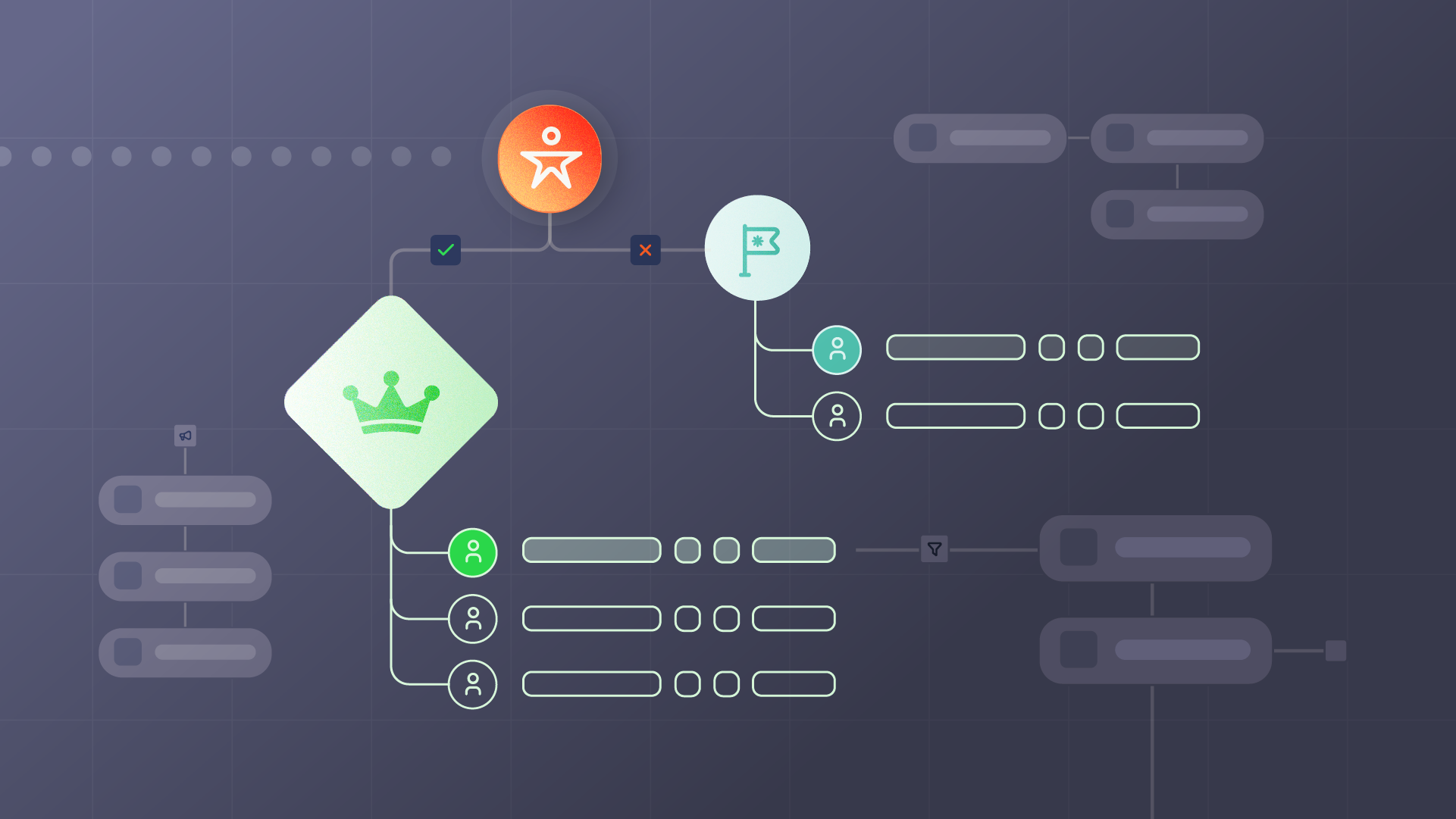A lead’s true value lies in its potential to become a paying customer.
That’s why marketers identify and prioritize leads that are likely to convert — while sales and sales operation teams focus on leads that are ready for direct engagement. This division of labor between MQL vs SQL ultimately optimizes your sales process and improves your conversion rates by helping you manage leads based on their readiness to buy.
What’s a Marketing Qualified Lead? (MQL)
A Marketing Qualified Lead (MQL) is a prospect who has shown interest in your product or service through marketing engagement but isn’t yet ready for direct sales outreach. MQLs typically match your ideal customer profile (ICP) and have interacted with marketing efforts — such as downloading content, attending a webinar, or visiting high-intent pages like pricing—but may still lack the budget, authority, or internal buy-in to make an immediate purchase.
Positioned in the middle of the sales funnel, MQLs require additional nurturing before transitioning into Sales Qualified Leads (SQLs).
MQL Examples
Marketing teams identify MQLs based on broad actions a customer takes that indicate interest and engagement. Some specific examples are:
- Subscribing to a newsletter
- Filling out online forms
- Downloading a whitepaper or eBook
- Registering for and attending a webinar
- Requesting a demo
- Engaging with your social media and web content
- Spending significant time on your website
What’s a Sales Qualified Lead? (SQL)
A Sales Qualified Lead (SQL) is a prospect who shows clear purchase intent and is ready for direct sales engagement. Unlike MQLs, SQLs have been vetted — typically by Sales Development Reps (SDRs)—to ensure they meet key criteria such as budget, authority, and purchasing readiness.
Positioned at the end of the consideration stage, SQLs are actively evaluating solutions, seeking detailed product information, and engaging in sales discussions to finalize their decision. This makes them prime targets for direct outreach and deal progression.
SQL Examples
Unlike MQLs, sales teams identify SQLs based on more targeted and decisive actions indicating their readiness to purchase. These actions include:
- Requesting a personalized quote
- Scheduling a meeting with a sales representative
- Discussing timelines and budgets with the sales team
- Requesting detailed product specifications and comparisons
Why Knowing the Difference Between MQL vs SQL Matters
Accurately categorizing leads as either MQLs vs SQLs is critical for proper lead nurturing.
Imagine you have a lead that’s on the cusp of a purchasing decision. It doesn’t make sense to send them introductory materials about your offerings when they’re already well-informed and ready to take the next step.
On the other hand, leads still exploring your product and trying to understand its features and benefits — aren’t ready for a sales call. Pushing them too soon can feel coercive, especially if they haven’t secured the approval or budget to move forward.
SQLs, with their higher intent, benefit from a more direct and personalized approach, allowing sales reps to engage them at the right moment to maximize conversion potential. MQLs, meanwhile, continue to receive the educational content they need until they’re ready for deeper engagement from sales.
By tailoring your approach based on this difference, you reduce friction in the buyer’s journey, improve the effectiveness of your sales and marketing teams, and drive higher-quality conversions.
Converting an MQL to SQL in Salesforce – 4 Best Practices
Determining when an MQL is ready for conversion into an SQL is tricky.
Move too early and the lead might not be ready for a sales conversation. Wait too long and the lead’s interest might cool or they may turn to a competitor, making your speed to lead crucial.
This is why timing and communication between your marketing and sales teams are crucial for the MQL vs SQL transition.
Both teams must agree on what makes a lead ready for sales engagement. Without this alignment, marketing might pass along leads that sales don’t consider ready, leading to frustration and wasted effort.
Strong alignment is also crucial because this handoff is where marketing’s nurturing efforts either convert into a successful sales opportunity or fail. A poorly managed transition risks disengaging the lead and losing them entirely.
Given these challenges, maximizing your MQL to SQL conversion rate requires a strategic approach. If you’re using Salesforce as your CRM, follow these four best practices for a smooth and effective transition.
1. Clean and dedupe records before handoff
Leads can come from multiple sources simultaneously, so before you hand an MQL off to sales, clean your lead data.
Imagine your marketing team captures a lead through a webinar registration, but that same person also downloads a gated whitepaper from your website. If your CRM doesn’t recognize these actions as coming from the same individual, it’ll create two separate lead records.
On average, dirty data costs companies $96 per duplicate.
Without proper Salesforce data deduplication, this lead might go to Sales as two different MQLs. Two reps could reach out, potentially offering the same information or a rep might try booking a demo when the lead is already a customer. Awkward!
Other factors that can create duplicate records include:
- Integrations. When Marketing Automation Platforms (MAPs) and other integrated tools push records into your CRM without proper data quality governance, duplicates can easily slip through.
- Data imports. Bulk list uploads from marketing events, mergers, and acquisitions can introduce multiple versions of the same contact.
- Lack of clear processes. If there isn’t a quick and standardized way for users to check whether a lead or contact already exists in the CRM, they might create new records without verifying first.
What to do
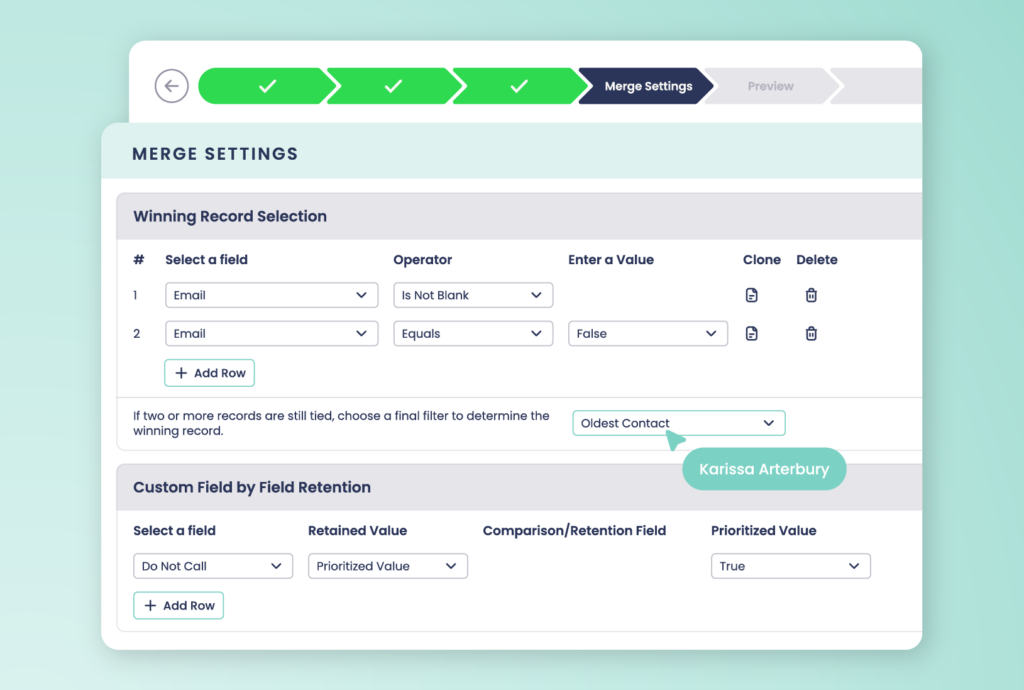
Before handing leads off, clean your records by using data hygiene tools like Salesforce’s built-in Duplicate Management.
This feature lets you set up Matching Rules and Duplicate Rules to detect potential duplicates based on criteria like email address, name, and phone number. When it finds a duplicate, Salesforce can either block the creation of the new record, alert a user to review the duplicates or merge them manually based on predefined rules.
While you can configure some of these processes in Salesforce Flows, automatic merging isn’t available with out-of-the-box Salesforce.
2. Enrich your lead records
If your data isn’t clean and accurate, your lead handoff — and the MQL vs SQL process — will suffer.
Even if your marketing team generates leads that seem valuable, your sales team might dismiss them due to missing or incomplete data.
On the flip side, a lack of detailed information increases lead handoff problems like misrouting leads to the wrong reps and creating additional data chores.
Let’s say a lead comes in from a firm based out of California but you find out later that they’re actually a subsidiary of a much larger enterprise company like Verizon. Without knowing firmographic data like size, industry, and hierarchical relationships, you risk incorrectly routing that lead to a mid-market rep in California instead of an account manager who specializes in large enterprises.
Since you don’t have that account hierarchy data, you (and the Ops team) now have to contend with territory conflicts, commission splits, and manual record updates to correct the mistake.
What to do
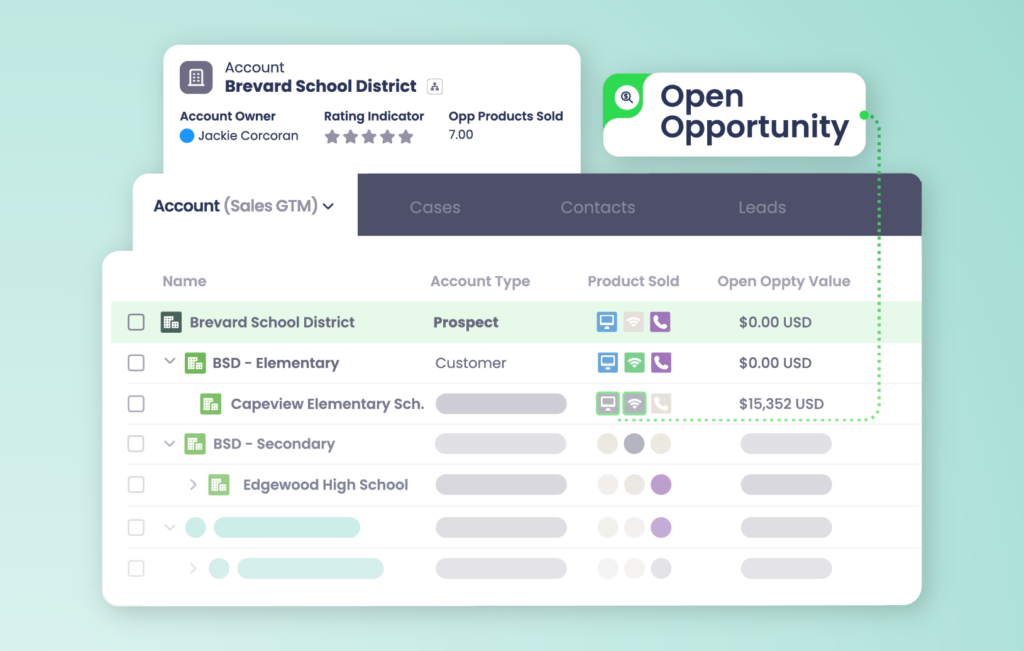
Studies show that businesses that respond to leads within an hour are seven times more likely to qualify them. But speed alone isn’t enough — accuracy in lead assignment and follow-up is just as important.
To respond quickly and effectively, your sales team needs complete and accurate data at their fingertips, allowing them to act immediately without having to fill in the gaps themselves.
Depending on your lead sources and volume, sourcing this data manually isn’t an option if you want to maintain fast lead response rates.
To avoid the above complications and ensure your team can respond quickly and effectively, automate the data enrichment process by using third-party data providers like Dun & Bradstreet and ZoomInfo.
These tools automatically add insights such as contact details, financial data, and other firmographic information to your Salesforce leads. The enriched data gives sales teams a clearer picture of the lead’s potential, making it easier to determine if the lead is ready for handoff from marketing (an MQL) to sales (as an SQL).
This process also eliminates the need for prospects to fill out additional fields that could lower your web-to-lead conversion rate. And it spares your sales reps from having to manually source and input missing or incorrect data, allowing your team to focus on what truly matters — engaging with leads and moving them through the sales funnel.
Pro Tip: Visualize and Connect Firmographic Data to Maximize Revenue
Firmographic data is great, but you risk leaving revenue on the table if you can’t visualize and action that data.
Unlike firmographic data, hierarchy data reveals how companies are connected — from parent-subsidiary relationships to organizational structures within large enterprises.
Since third-party data providers can’t build these relationships in Salesforce, use tools like Complete Hierarchies to visualize parent-subsidiary links and uncover upsell and cross-sell opportunities across an entire organization.
3. Use advanced lead routing automation
Effective lead routing can make the difference between a lead that converts and one that falls through the cracks.
However, many teams rely on lead routing flows created through Salesforce’s Flow Builder, which can become a bottleneck as your business scales. These flows, while useful for basic routing needs, struggle to meet the demands of growing organizations.
As your company expands into new industries, launches new products, or enters new territories, the complexity of your lead routing rules naturally increases. Different sales reps might specialize in various industries, regions, or product lines, so your routing rules must adapt to direct each lead to the most appropriate person.
Introducing more products, expanding into new regions, and targeting diverse industries require evolving your routing rules to maintain efficiency. It’s not just about assigning the lead to the next available rep — it’s about ensuring the lead reaches the rep most capable of converting that interest into a sale.
This targeted approach is especially critical when converting MQL to SQLs because this conversion hinges on leads receiving relevant, timely, and informed follow-ups.
But since Salesforce administrators create and manage these flows, you run into several challenges:
- Inadaptability. Building and maintaining these flows often requires custom APEX code, making them difficult to adjust on the fly. When your go-to-market (GTM) rules change, rigid routing rules can lead to inefficiencies and missed opportunities.
- Dependency on Salesforce Administrators and Developers. Salesforce admins and developers manage flows, so any changes to routing rules require their intervention. This dependence creates a bottleneck, especially if you need to make frequent updates to accommodate new strategies, team changes, and market shifts.
- Limited scalability. The volume and complexity of your leads grow in tandem with your business, so routing rules that worked when you were smaller might not suffice as you expand.
Veracode, a global leader in application security and services, experienced these problems firsthand with its Salesforce Flows.
As operations scaled, its team relied on Salesforce admins and developers for additional APEX code to manage the increased lead volume and complexity. Despite having nearly 900 rule criteria for assigning leads, its lead routing system couldn’t match all the incoming leads.
Worse, Veracode frequently encountered APEX CPU time limit errors due to the complexity of their flows. This caused leads to land in a catchall queue, requiring the team to manually review and assign each lead to an appropriate owner — costing them hours of productivity each week.
What to do
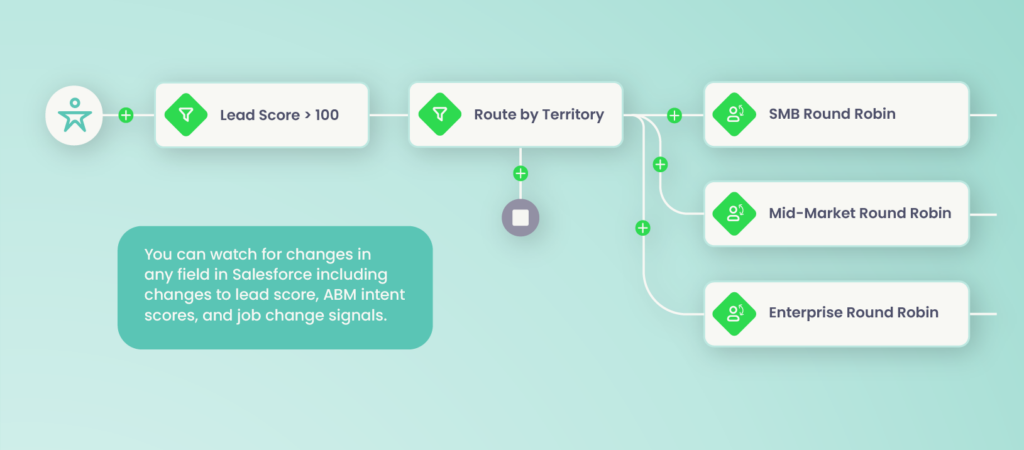
To avoid the challenges that come with scaling your lead routing processes, implement advanced routing automation — like Complete Leads — that offer greater flexibility and scalability than traditional Salesforce Flows.
Thanks to Complete Lead’s intuitive drag-and-drop user interface, Veracode can now quickly build multiple types of lead routing flows tailored to different business requirements and seamlessly manage the transition from MQL vs SQL.
For example, Veracode configured triggers that automatically reassign leads when new data — such as updated lead scores from marketing automation tools — become available. This setup ensures that even leads initially placed in a catch-all queue due to incomplete data get re-evaluated and reassigned to the right sales rep as soon as they meet the criteria to qualify as SQLs.
Additional benefits that an advanced routing automation engine like Complete Leads offer include:
- Visual-first interface. A user-friendly, drag-and-drop interface lets you create, modify, and troubleshoot routing rules on the fly. This means that even non-technical users can modify matching and routing flows in minutes without needing a Salesforce Admin or developer support.
- Complex routing support. Complete Leads effectively handles complex routing scenarios by supporting lead-to-account matching and referencing any object in Salesforce, including contacts, opportunities, and custom objects.
- Visual history log. A detailed visual history log tracks every step of the routing process and lets you audit how team members assign leads.
- Multi-user permissions. Complete Leads support multi-user permissions, allowing different business units and teams to manage their own routing rules.
- Automated inbound lead assignment. Complete Leads lets you automatically route new leads from various sources — such as form submissions, list uploads, and manual entries — directly to the appropriate sales rep.
4. Automate lead-to-account matching
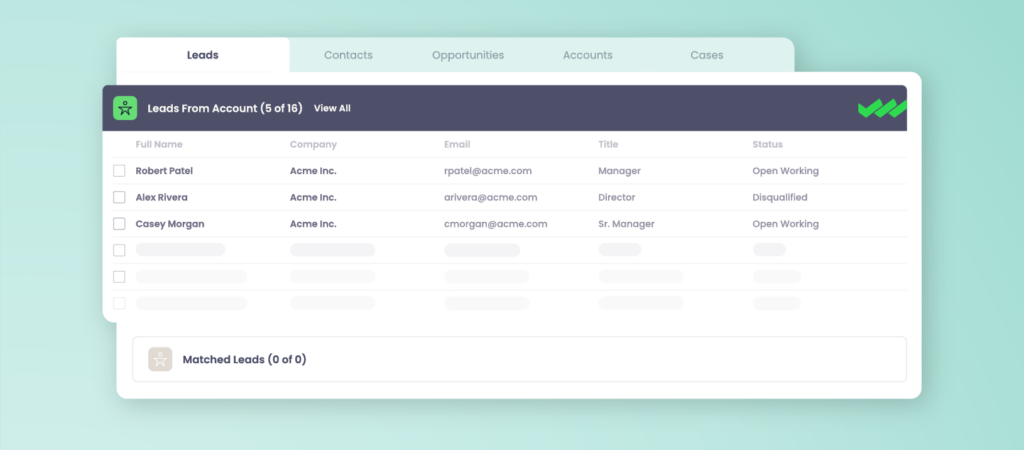
We’ve already explored how advanced lead routing automation keeps your team agile, but one strategy that demands further attention within this framework is lead-to-account matching. This process helps you connect the dots between individual leads and the broader organizational context, giving your sales reps the full picture before they reach out.
Without it, you’re not just missing out on efficiency — you’re potentially leaving valuable opportunities on the table.
When reps lack insight into the relationships and history tied to a lead, they risk overlooking valuable opportunities and crafting ineffective follow-ups.
Let’s say a lead comes in with the following details:
- Name. John Smith
- Company. Johnson Technology
- Title. Operations
At first glance, the lead might not look too promising from an MQL vs SQL standpoint. But the real problem arises when BDRs spend time searching within Salesforce to answer questions like:
- How big is Johnson Technology?
- Have we spoken to Johnson Technology before?
- Who do we know at Johnson Technology?
- What has our relationship been like with Johnson Technology in the past?
Without this context readily available, BDRs might send a generic follow-up email like, “Hi John, I see you’re interested in our product. Let’s book a time to chat.”
This approach is generic, isn’t personalized, and forces your sales team to waste time to get up-to-speed with the account.
What to do
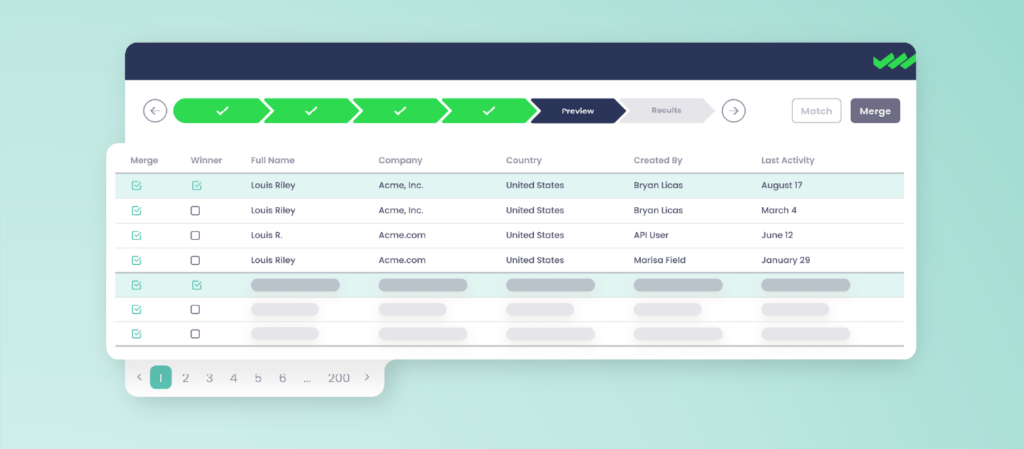
Ensure your sales team engages leads effectively and efficiently by automating the lead-to-account matching process.
Following our above example, automating the lead-to-account matching process lets you instantly build a lookup between John Smith’s lead record and the corresponding account record for Johnson Technology.
Through this match, your BDR can quickly access critical information such as:
- A previous deal cycle with Johnson Technology from 12 months ago
- An Account Executive on your team who has strong connections with four members of the Operations team at Johnson Technology
- Specific technologies Johnson Technology uses, like Salesforce and HubSpot, which you can pull directly from the account record and stamp onto the lead record
This automated process saves BDRs time and immediately equips them with the context they need. Armed with this detailed background, a BDR can craft a follow-up email that’s much more tailored and impactful, like:
“Hi John, we spoke with Tammy and Brenda on your team last year about our solution for Salesforce and our HubSpot integration. It wasn’t the right time then, but I’d love to reconnect and see how we can help now.”
Tools like Complete Leads even offer features that give reps a quick glance into the relationship between the lead and related records, ensuring that every follow-up is informed, personalized, and positioned to convert.
Mastering the MQL vs SQL Transition in Salesforce
The success of your sales and marketing efforts hinges on how effectively you manage the MQL vs SQL transition. To maximize your teams’ success, focus on implementing the four key processes we’ve outlined above — or just get Complete Leads to simplify and automate the entire process for you.

Take your data cleansing to the next level
Salesforce’s tool is useful, but it has its limitations. It can manage objects like Leads, Contacts, and Accounts, but leaves custom objects on the table. You’ll also have limited rules and criteria customization, making it difficult to identify duplicates with multiple fields.
For the cleanest CRM data, use a mass deduplication tool like Complete Clean that supports standard and custom Salesforce objects. Additional features like customizable survivorship and field-by-field retention rules, tiebreaker criteria, and merge previews gives you full control over your data, helping you ensure only the most valuable and accurate information remains in Salesforce.
Complete Clean also cleans large volumes of records at once, automating the entire process so your team doesn’t have to manage it manually.
Click here to see how Complete Clean compares to Salesforce or get our step-by-step guide and discover how painless our deduplication process is.


